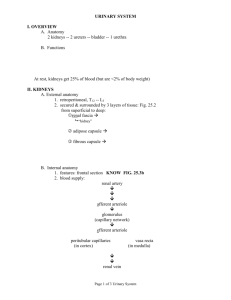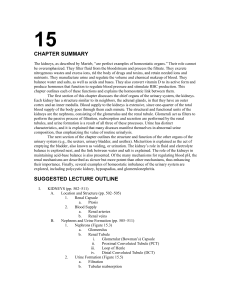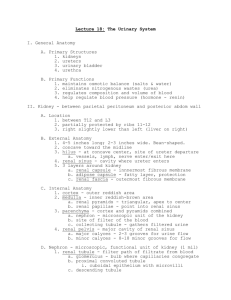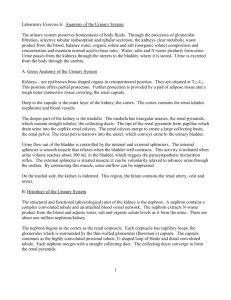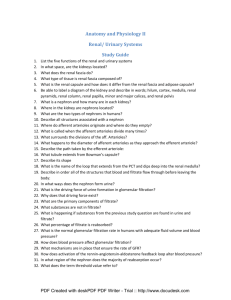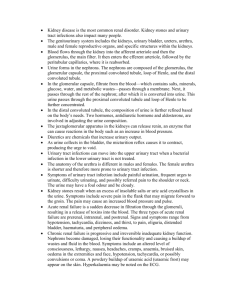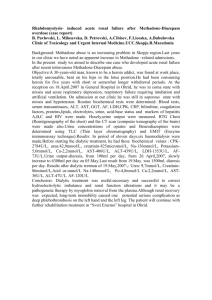20. Urinary I - Anat.-phys
advertisement
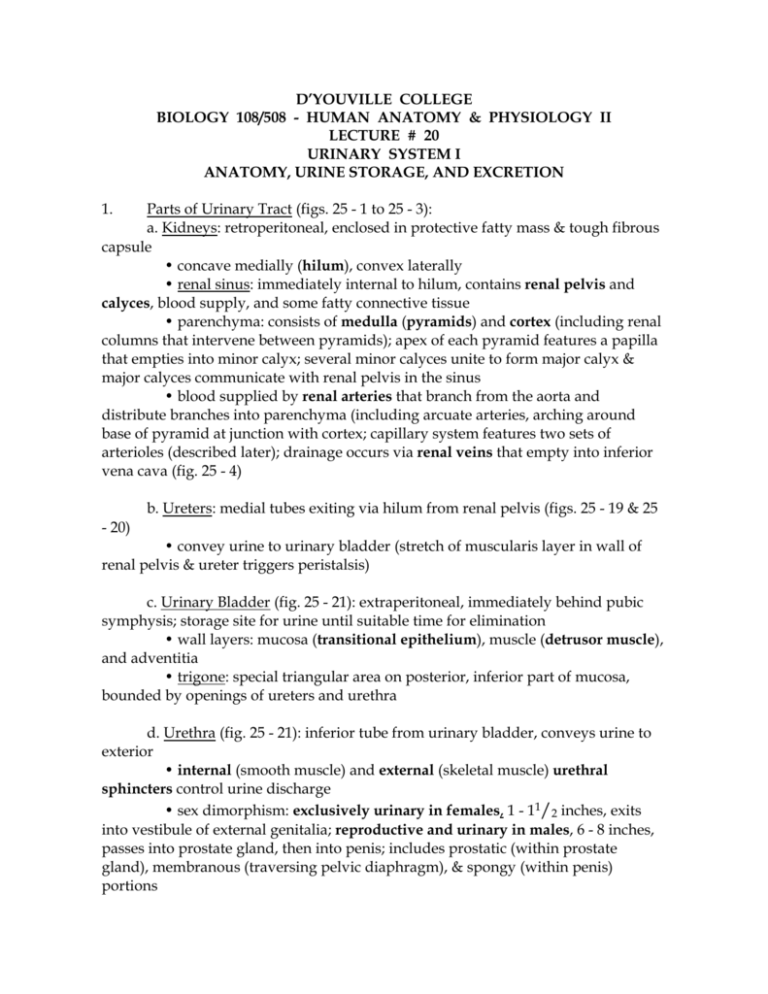
D’YOUVILLE COLLEGE BIOLOGY 108/508 - HUMAN ANATOMY & PHYSIOLOGY II LECTURE # 20 URINARY SYSTEM I ANATOMY, URINE STORAGE, AND EXCRETION 1. Parts of Urinary Tract (figs. 25 - 1 to 25 - 3): a. Kidneys: retroperitoneal, enclosed in protective fatty mass & tough fibrous capsule • concave medially (hilum), convex laterally • renal sinus: immediately internal to hilum, contains renal pelvis and calyces, blood supply, and some fatty connective tissue • parenchyma: consists of medulla (pyramids) and cortex (including renal columns that intervene between pyramids); apex of each pyramid features a papilla that empties into minor calyx; several minor calyces unite to form major calyx & major calyces communicate with renal pelvis in the sinus • blood supplied by renal arteries that branch from the aorta and distribute branches into parenchyma (including arcuate arteries, arching around base of pyramid at junction with cortex; capillary system features two sets of arterioles (described later); drainage occurs via renal veins that empty into inferior vena cava (fig. 25 - 4) b. Ureters: medial tubes exiting via hilum from renal pelvis (figs. 25 - 19 & 25 - 20) • convey urine to urinary bladder (stretch of muscularis layer in wall of renal pelvis & ureter triggers peristalsis) c. Urinary Bladder (fig. 25 - 21): extraperitoneal, immediately behind pubic symphysis; storage site for urine until suitable time for elimination • wall layers: mucosa (transitional epithelium), muscle (detrusor muscle), and adventitia • trigone: special triangular area on posterior, inferior part of mucosa, bounded by openings of ureters and urethra d. Urethra (fig. 25 - 21): inferior tube from urinary bladder, conveys urine to exterior • internal (smooth muscle) and external (skeletal muscle) urethral sphincters control urine discharge • sex dimorphism: exclusively urinary in females, 1 - 11/2 inches, exits into vestibule of external genitalia; reproductive and urinary in males, 6 - 8 inches, passes into prostate gland, then into penis; includes prostatic (within prostate gland), membranous (traversing pelvic diaphragm), & spongy (within penis) portions Bio 108/508 lec. 20 - p. 2 e. Micturition Reflex (fig. 25 - 22): distension of bladder with accumulated urine, causes sensory signals to spinal reflex & to pons, interpreted as “urgency” • parasympathetic signals relax internal urethral sphincter and stimulate contraction of detrusor muscle • voluntary prevention - contraction of external urethral sphincter Bio 108/508 lec. 20 - p. 3 2. Nephron Anatomy: a. Nephron: functional unit of kidney; renal tubule intimately associated with blood capillaries; approximately one million per kidney (figs. 25 - 5 & 25 - 7) • cortical (6/7 of total) & juxtamedullary nephrons (1 out of 7) b. 2 sets of arterioles and 2 sets of capillaries: • afferent arteriole supplies glomerulus (filtration capillary), drained by efferent arteriole that supplies peritubular capillaries (absorbing capillaries) c. Parts: glomerular (Bowman’s) capsule + glomerulus = renal corpuscle • filtrate passes from glomerular capsule to proximal convoluted tubule, nephron loop (of Henle), distal convoluted tubule and finally to collecting duct • proximal tubule is lined by epithelium with extensive microvilli (higher absorption capability) • nephron loop features ascending and descending limbs + thick and thin segments • each collecting duct receives fluid from several nephrons • fluid exits collecting duct (completed urine) via renal papilla, entering a minor calyx d. Juxtaglomerular Apparatus (fig. 25 - 8): • macula densa (cells of ascending limb of Henle's loop or distal tubule) & juxtaglomerular cells (surrounding afferent arteriole) • juxtaglomerular cells secrete renin (causes formation of angiotensin in plasma = renin-angiotensin system) • angiotensin: vasoconstriction, aldosterone release by adrenal cortex, & ADH release by posterior pituitary


